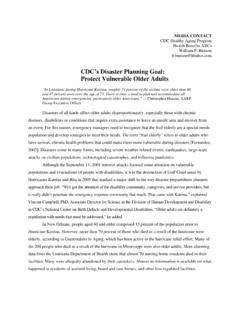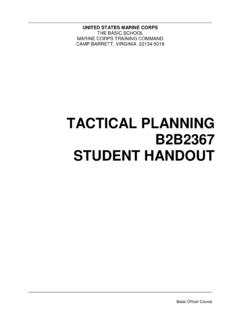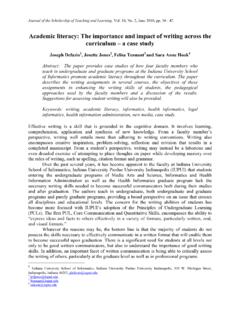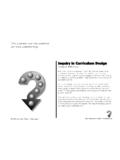Transcription of The Economic Importance of Financial Literacy: Theory and ...
1 NBER WORKING PAPER SERIES. THE Economic Importance OF Financial LITERACY: Theory AND EVIDENCE. Annamaria Lusardi Olivia S. Mitchell Working Paper 18952. NATIONAL BUREAU OF Economic RESEARCH. 1050 Massachusetts Avenue Cambridge, MA 02138. April 2013. The research reported herein was performed pursuant to a grant from the TIAA-CREF Institute; additional research support was provided by the Pension Research Council and Boettner Center at the Wharton School of the University of Pennsylvania. The authors thank Tabea Bucher-Koenen, Janet Currie, and Maarten van Rooij for suggestions, and Carlo de Bassa Scheresberg, Hugh Kim, Donna St. Louis, and Yong Yu for research assistance. Opinions and conclusions expressed herein are solely those of the authors and do not represent the opinions or policy of the funders or any other institutions with which the authors are affiliated The views expressed herein are those of the authors and do not necessarily reflect the views of the National Bureau of Economic Research.
2 At least one co-author has disclosed a Financial relationship of potential relevance for this research. Further information is available online at NBER working papers are circulated for discussion and comment purposes. They have not been peer- reviewed or been subject to the review by the NBER Board of Directors that accompanies official NBER publications. 2013 by Annamaria Lusardi and Olivia S. Mitchell. All rights reserved. Short sections of text, not to exceed two paragraphs, may be quoted without explicit permission provided that full credit, including notice, is given to the source. The Economic Importance of Financial Literacy: Theory and Evidence Annamaria Lusardi and Olivia S. Mitchell NBER Working Paper No. 18952. April 2013. JEL No. D91. ABSTRACT. In this paper, we undertake an assessment of the rapidly growing body of research on Financial literacy. We start with an overview of theoretical research which casts Financial knowledge as a form of investment in human capital.
3 Endogenizing Financial knowledge has important implications for welfare as well as policies intended to enhance levels of Financial knowledge in the larger population. Next, we draw on recent surveys to establish how much (or how little) people know and identify the least financially savvy population subgroups. This is followed by an examination of the impact of Financial literacy on Economic decision-making in the United States and elsewhere. While the literature is still growing, conclusions may be drawn about the effects and consequences of Financial illiteracy and what works to remedy these gaps. A final section offers thoughts on what remains to be learned if researchers are to better inform theoretical and empirical models as well as public policy. Annamaria Lusardi The George Washington University School of Business 2201 G Street, NW. Duques Hall, Suite 450E. Washington, DC 20052. and NBER. Olivia S. Mitchell University of Pennsylvania Wharton School 3620 Locust Walk, St 3000 SH-DH.
4 Philadelphia, PA 19104-6302. and NBER. 1. The Economic Importance of Financial Literacy: Theory and Evidence Annamaria Lusardi and Olivia S. Mitchell 1. Introduction Financial markets around the world have become increasingly accessible to the small investor,' as new products and Financial services grow widespread. At the onset of the recent Financial crisis, consumer credit and mortgage borrowing had burgeoned. People who had credit cards or subprime mortgages were in the historically unusual position of being able to decide how much they wanted to borrow. Alternative Financial services, including payday loans, pawn shops, auto title loans, tax refund loans, and rent-to-own shops have also become At the same time, changes in the pension landscape increasingly thrust responsibility for saving, investing, and decumulating wealth onto workers and retirees. Forty years ago, older Americans relied mainly on Social Security and employer-sponsored defined benefit (DB) pension plans in retirement, with participants mainly deciding when to claim benefits.
5 Today, by contrast, Baby Boomers mainly have defined contribution (DC) plans and Individual Retirement Accounts (IRAs) during their working years, which require them to decide how much to save and where to Moreover, during retirement, Boomers will increasingly need to take on responsibility for careful decumulation so as not to outlive their assets while meeting their needs. Yet many of these widely available Financial products student loans, mortgages, credit cards, pension accounts, annuities have proven to be complex and difficult for financially unsophisticated investors to master. So while Financial and pension developments have their advantages, by permitting tailored Financial contracts and more people to access credit, they also 1. See Lusardi (2011) and FINRA Investor Education Foundation (2009). 2. In the early 1980's, around 40 percent of private-sector pension contributions went to DC plans; two decades later, almost 90 percent of such contributions went to retirement accounts (mostly 401(k) plans; Poterba, Venti, and Wise 2008).
6 2. impose on households a much greater responsibility to borrow, save, invest, and decumulate their assets sensibly. One of our goals in this paper is to offer an assessment of how well-equipped today's households are to make these complex Financial decisions. Specifically we focus on Financial literacy, by which we mean peoples' ability to process Economic information and make informed decisions about Financial planning, wealth accumulation, pensions, and debt. In what follows, we outline recent theoretical research showing how Financial knowledge can be cast as a type of investment in human capital. In this approach, those who build Financial savvy can earn above- average expected returns on their investments, yet there will still be some optimal level of Financial ignorance. Endogenizing Financial knowledge in this way has important implications for welfare, and offers insights into programs intended to enhance levels of Financial knowledge in the larger population.
7 Another goal is to assess the effects of Financial literacy on behavior. We draw on surveys to establish how much (or how little) people know and which subgroups are the least financially literate. Most important, we evaluate the impact of Financial literacy on Economic decision-making in the United States and abroad, and what policies might help fill these gaps. The paper concludes with thoughts on what remains to be learned to better inform theoretical and empirical models, as well as public policy. 2. A Theoretical Framework for Financial Literacy The conventional Economic approach to saving and consumption decisions posits that a fully rational and well-informed individual will consume less than his income in times of high earnings, and he will save to support consumption when income falls ( after retirement). In this context, building on Modigliani and Brumberg (1954) and Friedman (1957), the consumer is 3. posited to arrange his optimal saving and decumulation patterns to smooth marginal utility over his lifetime.
8 Many studies have shown how such a life cycle optimization process can be shaped by consumer preferences ( risk aversion and discount rates), the Economic environment ( risky returns on investments and liquidity constraints), and social safety net benefits ( the availability and generosity of welfare schemes and Social Security income), among other Theoretical models incorporating such key aspects of consumer behavior and the Economic environment implicitly assume that people are able to formulate and execute saving and spend-down plans, all of which require expertise in dealing with Financial markets, knowledge of purchasing power, and the capacity to undertake complex Economic calculations. As we show below in more detail, this is far from true in the real world: very few people possess the extensive Financial knowledge conducive to making and executing complex plans. Moreover, acquiring such knowledge is likely to come at a cost. In the past, when retirement pensions were implemented and managed by governments, individual workers tended to devote little attention to the plan details.
9 Today, by contrast, saving, investment, and decumulation for retirement are occurring in an increasingly personalized pension environment. Accordingly, researchers and policymakers have begun to push for additional insights into the gaps between modeling and reality, so as to better evaluate where the Theory can be enriched, and how policy efforts can be better targeted. 3. For an older review of the saving literature see Browning and Lusardi (1996); recent surveys are provided by Skinner (2007) and Attanasio and Weber (2010). A very partial list of the literature discussing new theoretical advances includes Cagetti (2003); Chai, Horneff, Maurer and Mitchell (2012); DeNardi, French, and Jones (2011);. French (2005, 2008); Gourinchas and Parker (2002); Hurst and Aguiar (2005, 2007); and Scholz, Seshadri, and Khitatrakun (2006). 4. While there is a substantial theoretical and empirical body of work on the economics of education,4 far less attention has been devoted to the question of how people acquire and deploy Financial literacy.
10 In the last few years, however, a few authors have begun to explore the decision to acquire Financial literacy and the links between Financial knowledge, saving, and investment behavior including Delavande, Rohwedder, and Willis (2008), Jappelli and Padula (2011), Hsu (2011), and Lusardi, Michaud, and Mitchell (2013).5 The study by Delavande, Rohwedder, and Willis (2008) presents a simple two-period model of consumer saving and portfolio allocation across safe bonds and risky stocks, allowing for the acquisition of human capital in the form of Financial knowledge ( la Ben-Porath, 1967, and Becker, 1975). This work posits that individuals will optimally elect to invest in Financial knowledge so as to gain access to higher-return assets: this training helps them identify better-performing assets and/or hire Financial advisers who can reduce investment expenses. Hsu (2011) uses a similar approach in an intra-household setting where husbands specialize in the acquisition of Financial knowledge, but women are predicted to increase their acquisition of Financial knowledge when it becomes relevant, such as prior to the death of their spouse.















